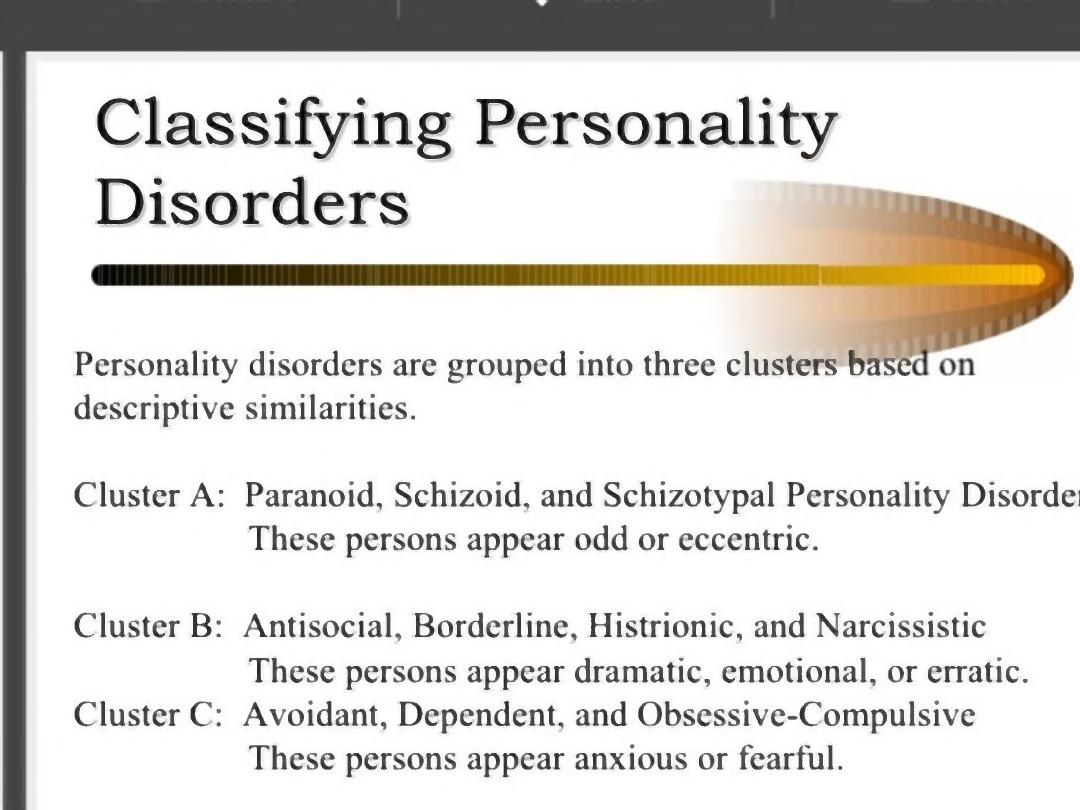
C lassifying P erso n ality
D iso rd ers
■i
Personality disorders arc grouped into three clusters base*
descriptive similarities.
Cluster A: Paranoid, Schizoid, and Schizotypal Personality Disordci
These persons appear odd or eccentric.
Cluster B: Antisocial, Borderline, Histrionic, and Narcissistic
These persons appear dramatic, emotional, or erratic.
Cluster C: Avoidant, Dependent, and Obsessive-Compulsive
These persons appear anxious or fearful.
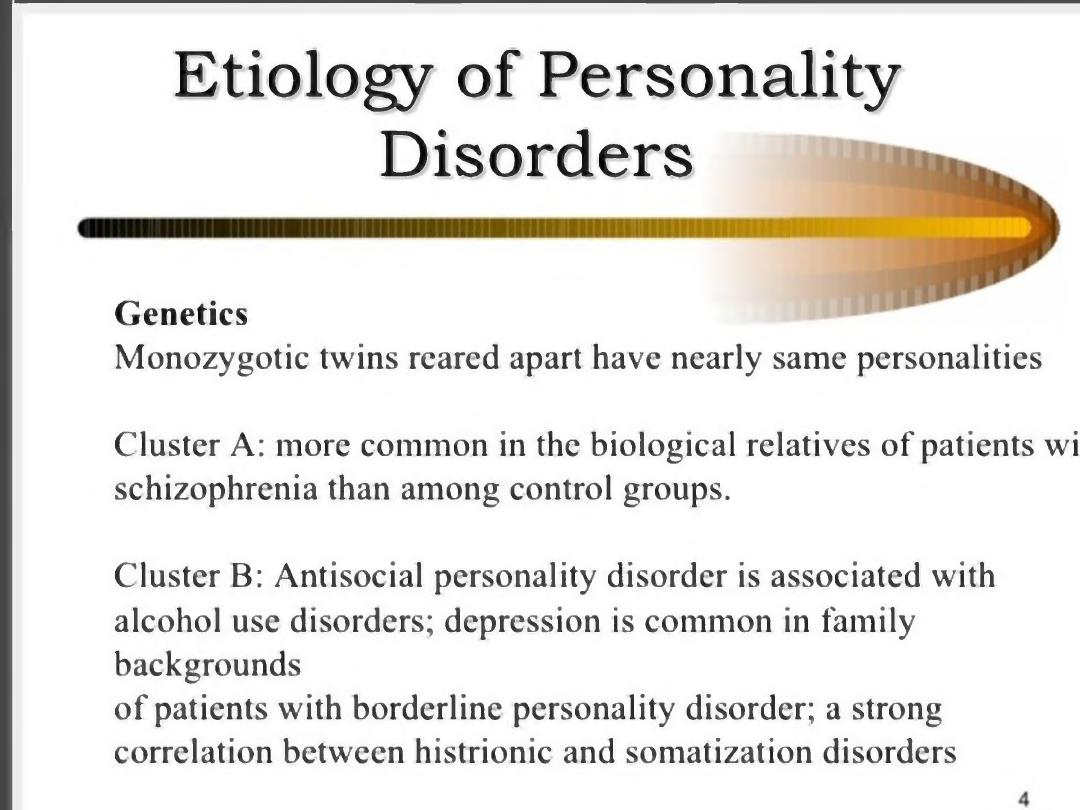
Etiology of Personality
Disorders
Genetics
Monozygotic twins reared apart have nearly same personalities
Cluster A: more common in the biological relatives of patients wi
schizophrenia than among control groups.
Cluster B: Antisocial personality disorder is associated with
alcohol use disorders; depression is common in family
backgrounds
of patients with borderline personality disorder; a strong
correlation between histrionic and somatization disorders
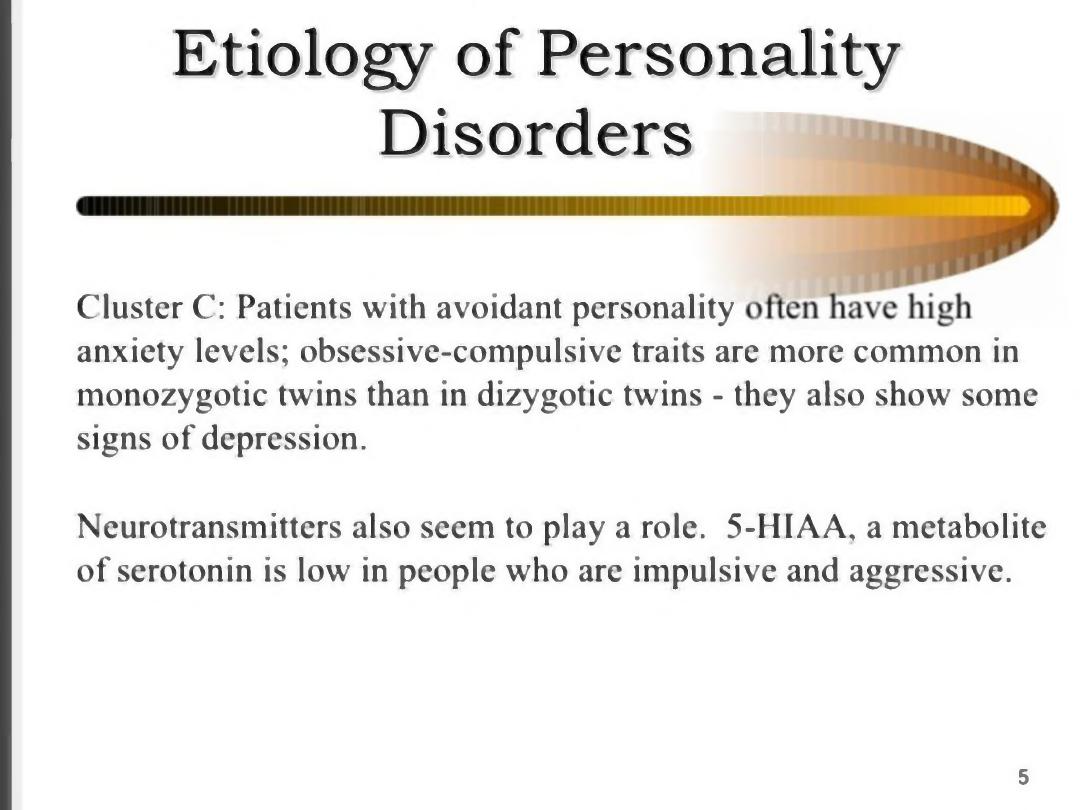
Cluster C: Patients with avoidant personality
anxiety levels; obsessive-compulsive traits arc more common in
monozygotic twins than in dizygotic twins - they also show some
signs of depression.
Neurotransmitters also seem to play a role. 5-HIAA, a metabolite
of serotonin is low in people who arc impulsive and aggressive.
Etiology of P erso n ality
D iso rd ers
5
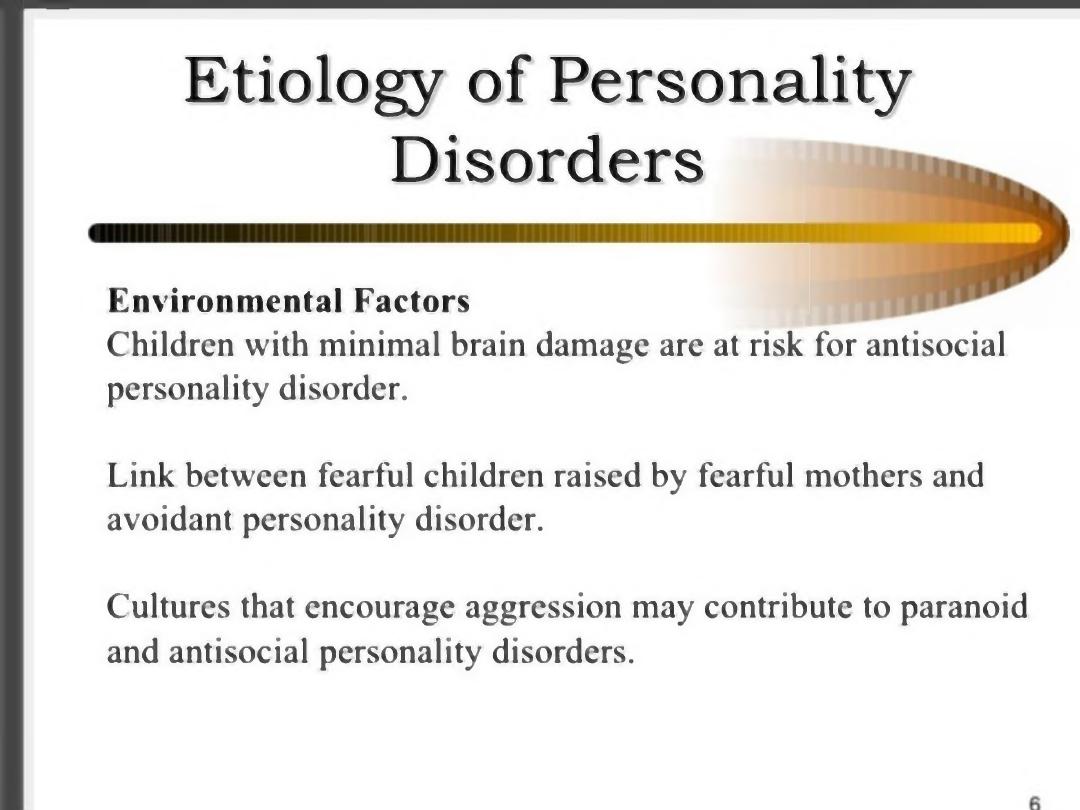
Etiology of P erso n ality
D iso rd ers
Environmental Factors
Children with minimal brain damage arc at risk for antisocial
personality disorder.
Link between fearful children raised by fearful mothers and
avoidant personality disorder.
Cultures that encourage aggression may contribute to paranoid
and antisocial personality disorders.
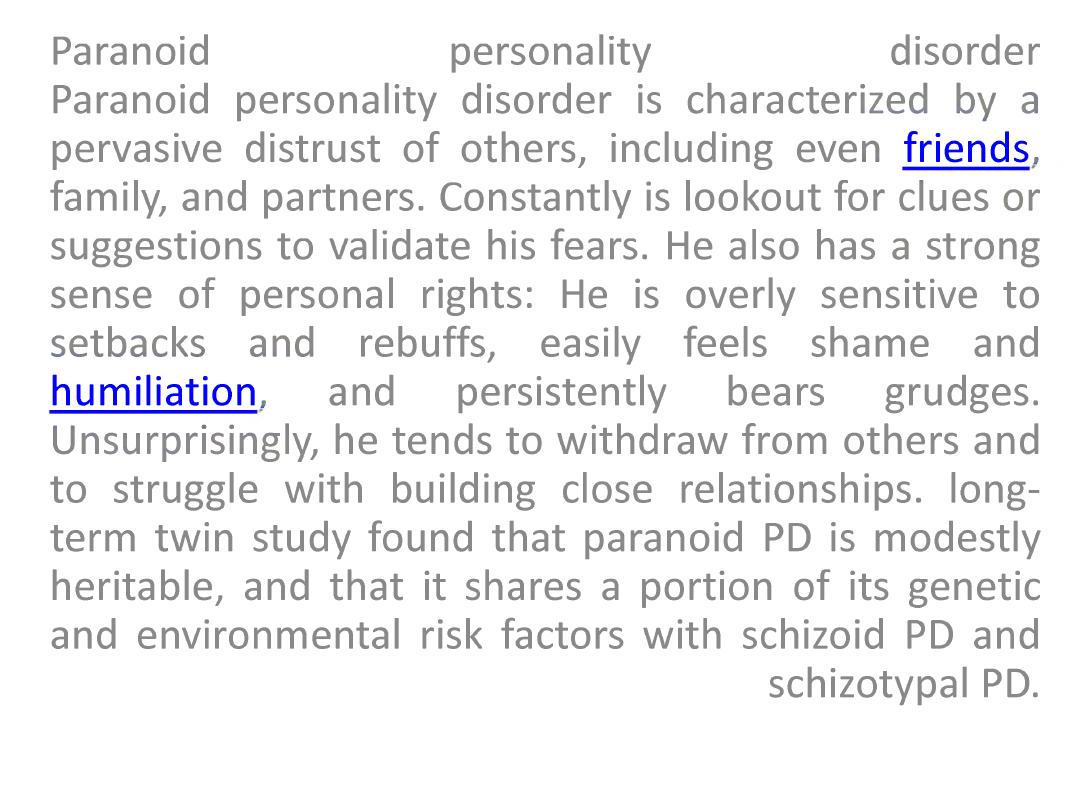
Paranoid
personality
disorder
Paranoid personality disorder is characterized by a
pervasive distrust of others, including even friends,
family, and partners. Constantly is lookout for clues or
suggestions to validate his fears. He also has a strong
sense of personal rights: He is overly sensitive to
setbacks and rebuffs, easily feels shame and
and
persistently
bears
grudges.
Unsurprisingly, he tends to withdraw from others and
to struggle with building close relationships. long
term twin study found that paranoid PD is modestly
heritable, and that it shares a portion of its genetic
and environmental risk factors with schizoid PD and
schizotypal PD.
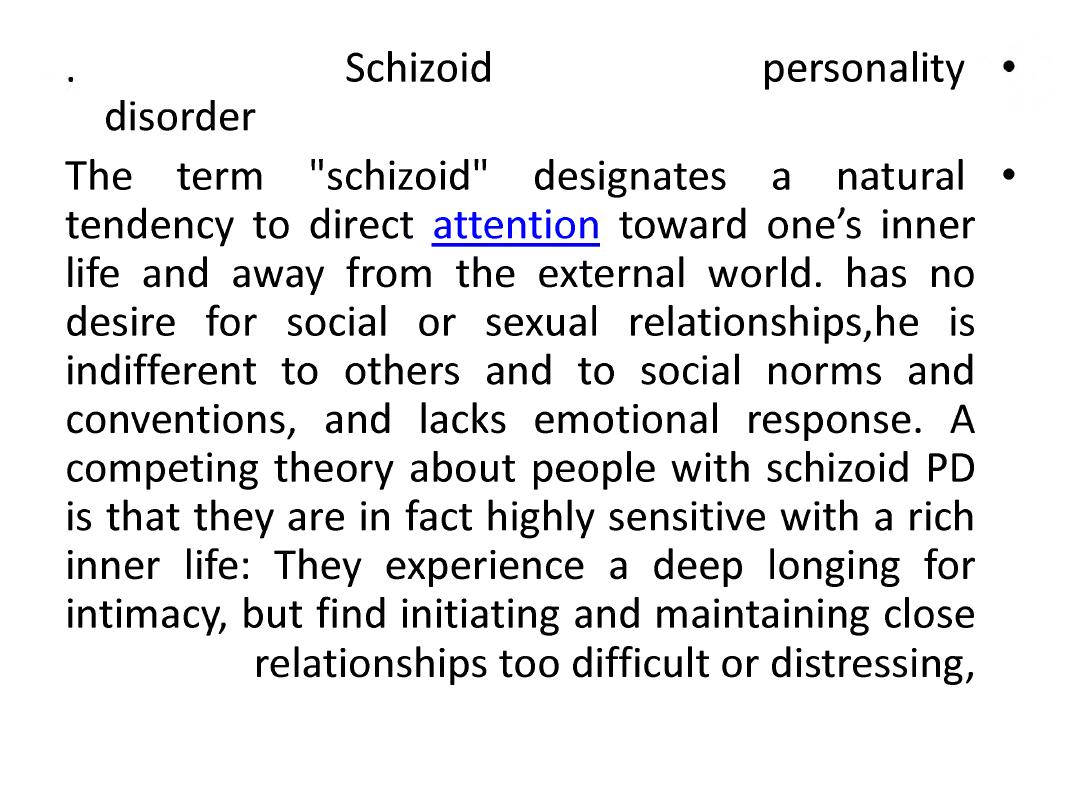
Schizoid
personality
disorder
The term "schizoid" designates a natural •
tendency to direct attention toward one's inner
life and away from the external world. has no
desire for social or sexual relationships,he is
indifferent to others and to social norms and
conventions, and lacks emotional response. A
competing theory about people with schizoid PD
is that they are in fact highly sensitive with a rich
inner life: They experience a deep longing for
intimacy, but find initiating and maintaining close
relationships too difficult or distressing,
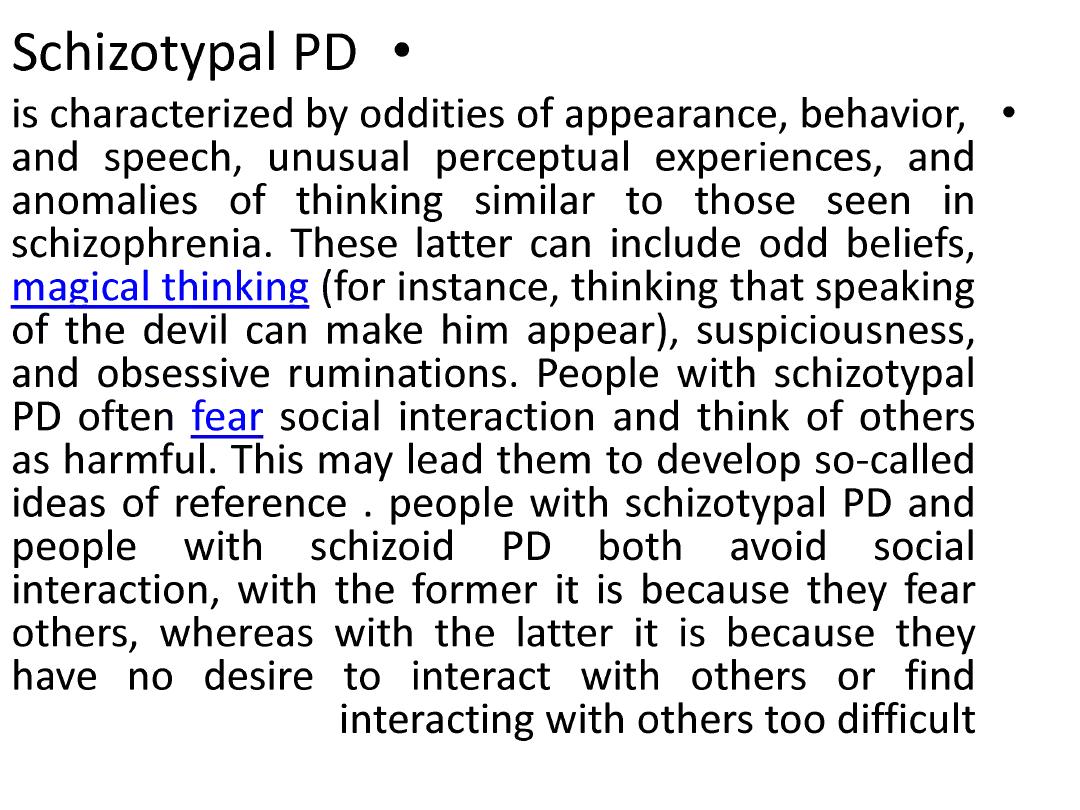
Schizotypal PD •
is characterized by oddities of appearance, behavior, •
and speech, unusual perceptual experiences, and
anomalies of thinking similar to those seen in
schizophrenia. These latter can include odd beliefs,
magical thinking (for instance, thinking that speaking
of the devil can make him appear), suspiciousness,
and obsessive ruminations. People with schizotypal
PD often fear social interaction and think of others
as harmful. This may lead them to develop so-called
ideas of reference . people with schizotypal PD and
people with schizoid PD both avoid social
interaction, with the former it is because they fear
others, whereas with the latter it is because they
have no desire to interact with others or find
interacting with others too difficult
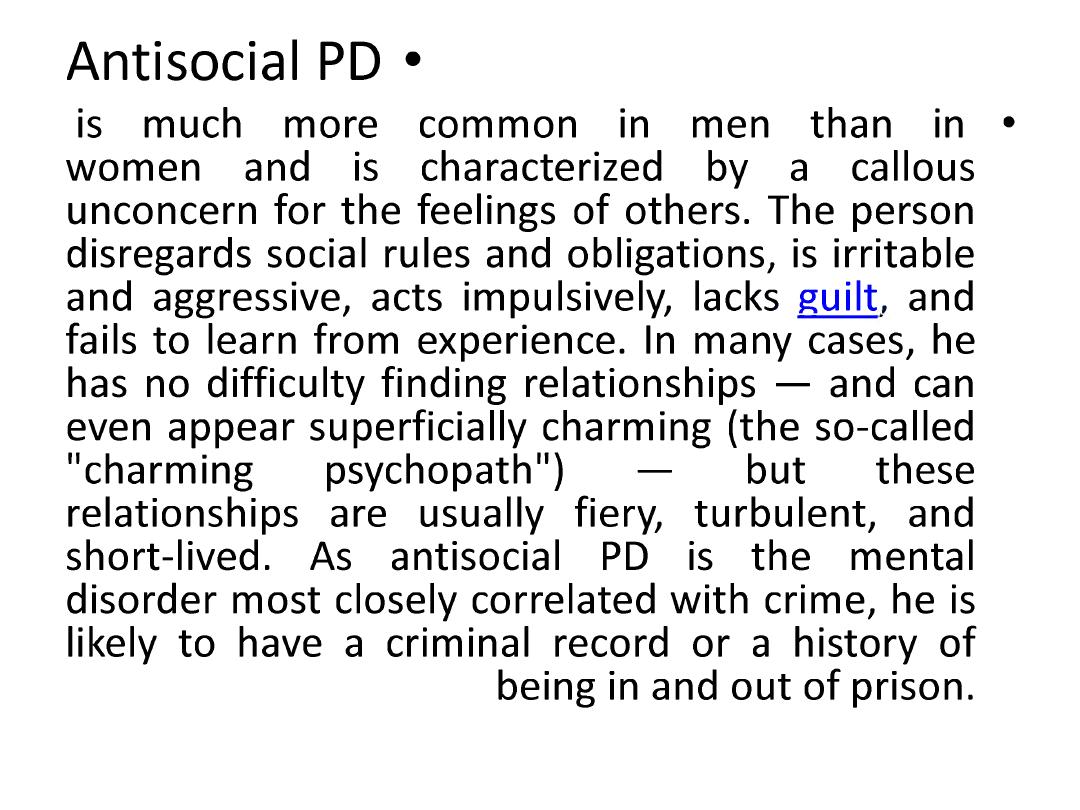
Antisocial PD •
is much more common in men than in •
women and is characterized by a callous
unconcern for the feelings of others. The person
disregards social rules and obligations, is irritable
and aggressive, acts impulsively, lacks guilt, and
fails to learn from experience. In many cases, he
has no difficulty finding relationships — and can
even appear superficially charming (the so-called
"charming
psychopath")
—
but
these
relationships are usually fiery, turbulent, and
short-lived. As antisocial PD is the mental
disorder most closely correlated with crime, he is
likely to have a criminal record or a history of
being in and out of prison.
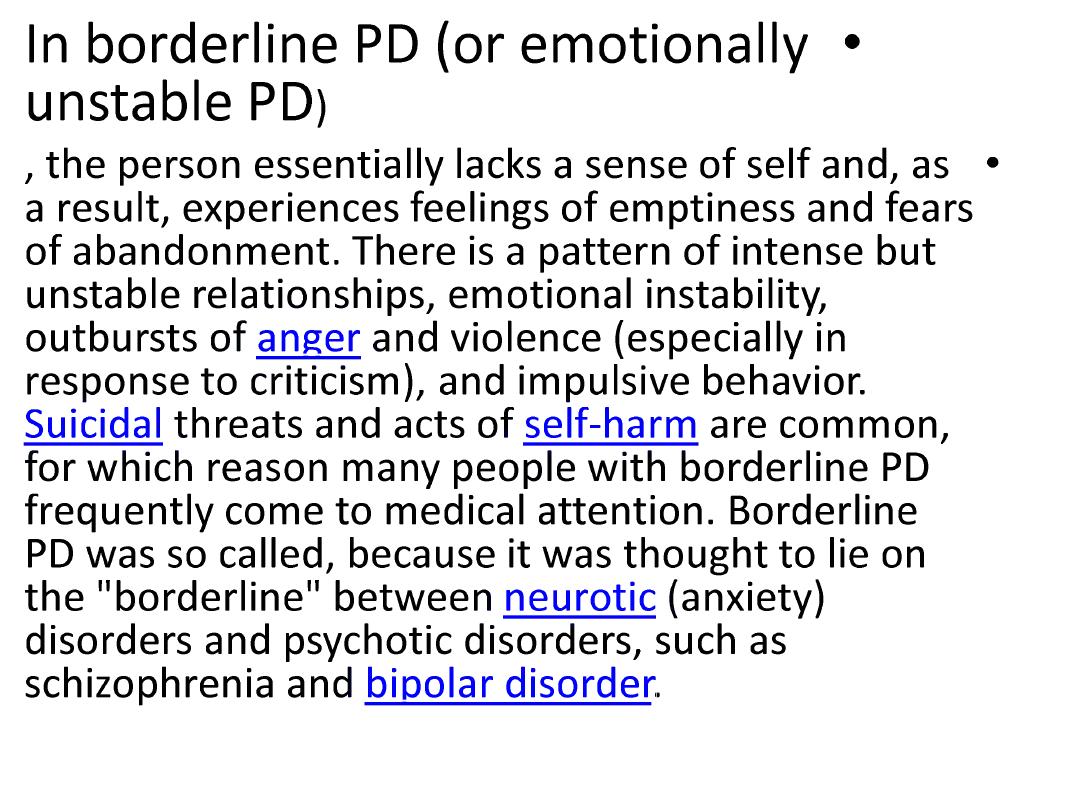
In borderline PD (or emotionally •
unstable PD
)
, the person essentially lacks a sense of self and, as •
a result, experiences feelings of emptiness and fears
of abandonment. There is a pattern of intense but
unstable relationships, emotional instability,
outbursts of anger and violence (especially in
response to criticism), and impulsive behavior.
Suicidal threats and acts of se f-harm are common,
for which reason many people with borderline PD
frequently come to medical attention. Borderline
PD was so called, because it was thought to lie on
the "borderline" between neurotic (anxiety)
disorders and psychotic disorders, such as
schizophrenia and bipolar disorder.
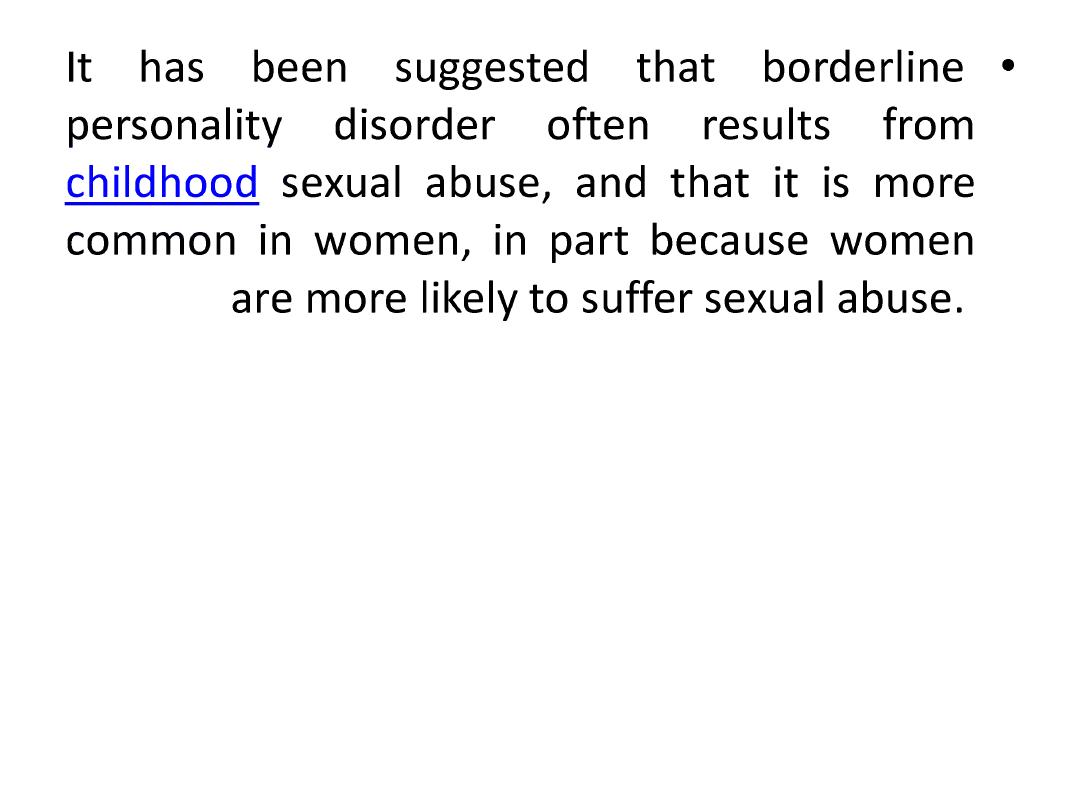
It has been suggested that borderline •
personality disorder often
results from
childhood sexual abuse, and that it is more
common in women, in part because women
are more likely to suffer sexual abuse.
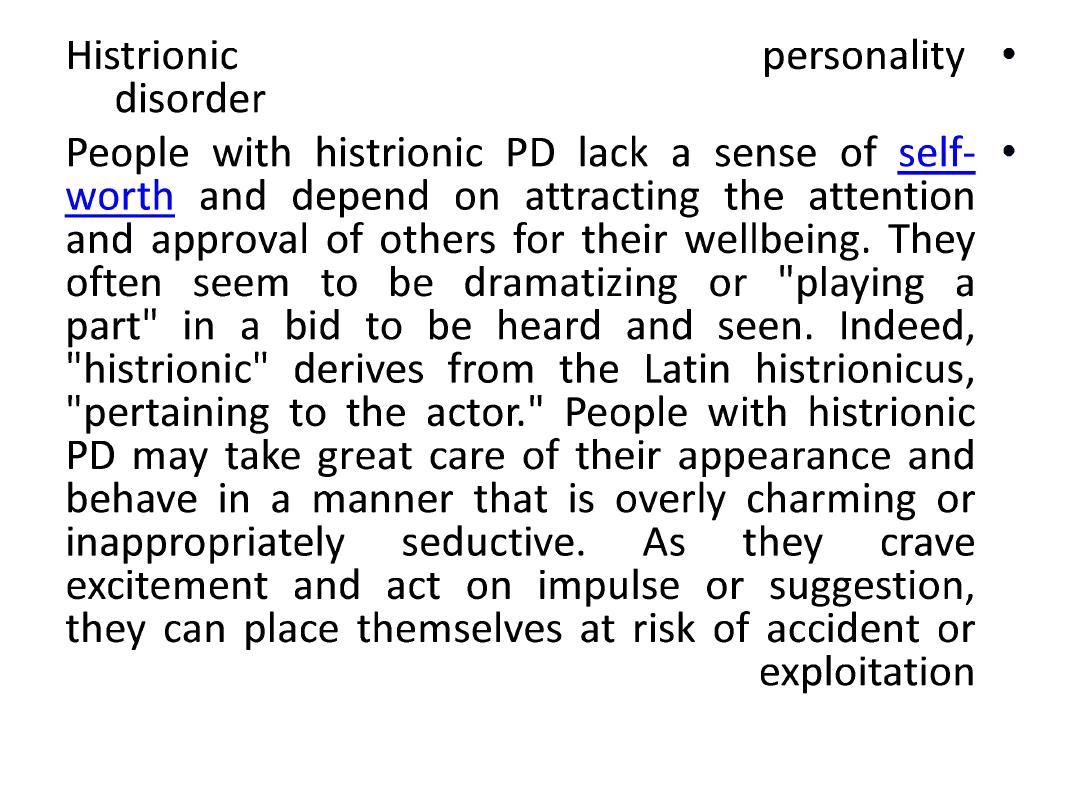
People with histrionic PD lack a sense of self- •
worth and depend on attracting the attention
and approval of others for their wellbeing. They
often seem to be dramatizing or "playing a
part" in a bid to be heard and seen. Indeed,
"histrionic" derives from the Latin histrionicus,
"pertaining to the actor." People with histrionic
PD may take great care of their appearance and
behave in a manner that is overly charming or
inappropriately
seductive.
As
they
crave
excitement and act on impulse or suggestion,
they can place themselves at risk of accident or
exploitation
Histrionic
personality •
disorder
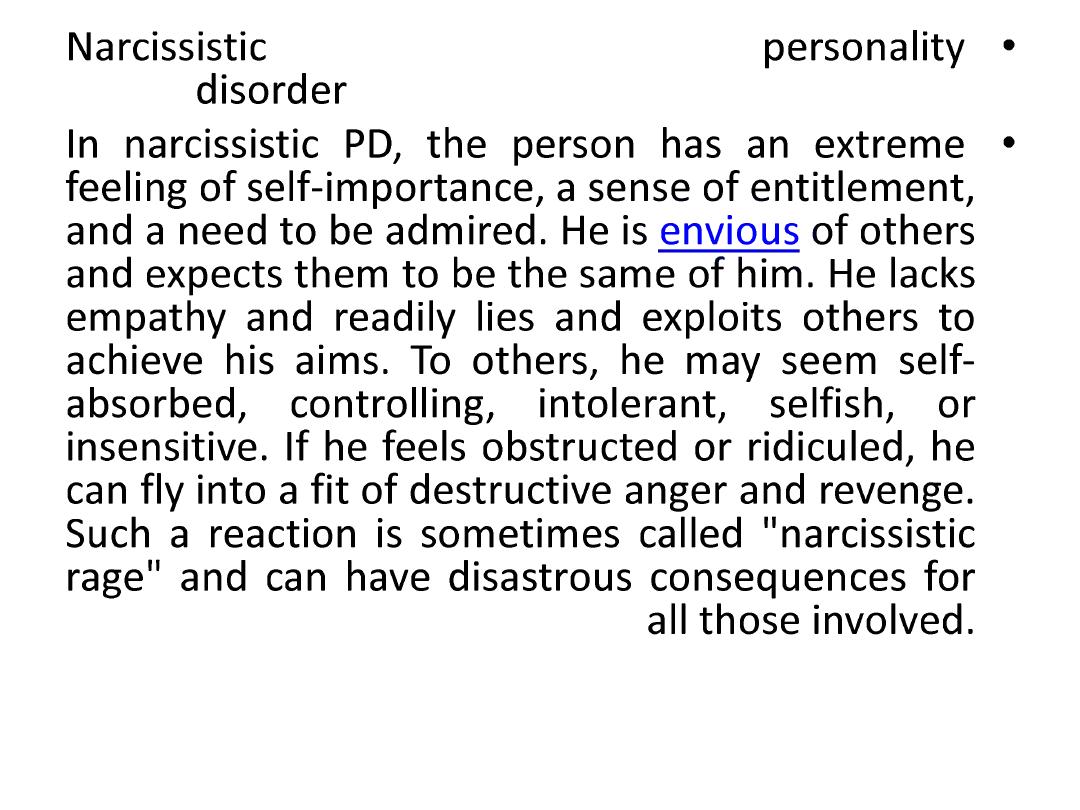
In narcissistic PD, the person has an extreme •
feeling of self-importance, a sense of entitlement,
and a need to be admired. He is envious of others
and expects them to be the same of him. He lacks
empathy and readily lies and exploits others to
achieve his aims. To others, he may seem self
absorbed, controlling, intolerant, selfish, or
insensitive. If he feels obstructed or ridiculed, he
can fly into a fit of destructive anger and revenge.
Such a reaction is sometimes called "narcissistic
rage" and can have disastrous consequences for
all those involved.
Narcissistic
personality •
disorder
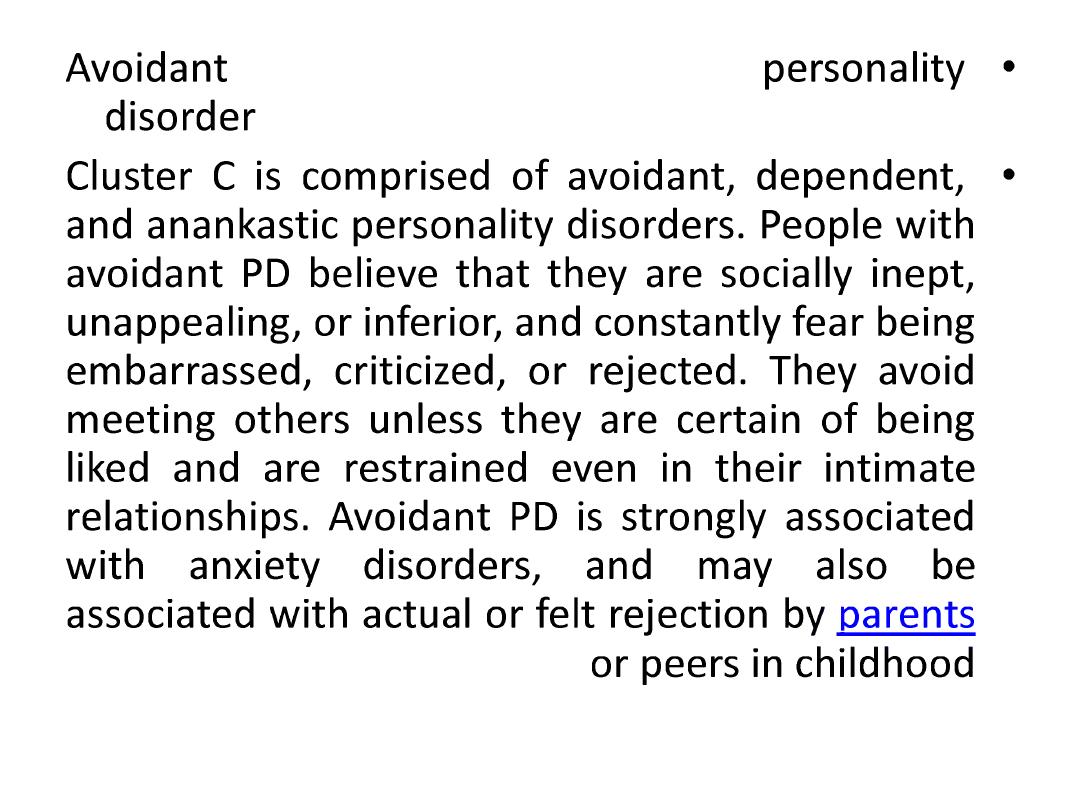
Cluster C is comprised of avoidant, dependent, •
and anankastic personality disorders. People with
avoidant PD believe that they are socially inept,
unappealing, or inferior, and constantly fear being
embarrassed, criticized, or rejected. They avoid
meeting others unless they are certain of being
liked and are restrained even in their intimate
relationships. Avoidant PD is strongly associated
with anxiety disorders, and may also be
associated with actual or felt rejection by parents
or peers in childhood
Avoidant
personality •
disorder
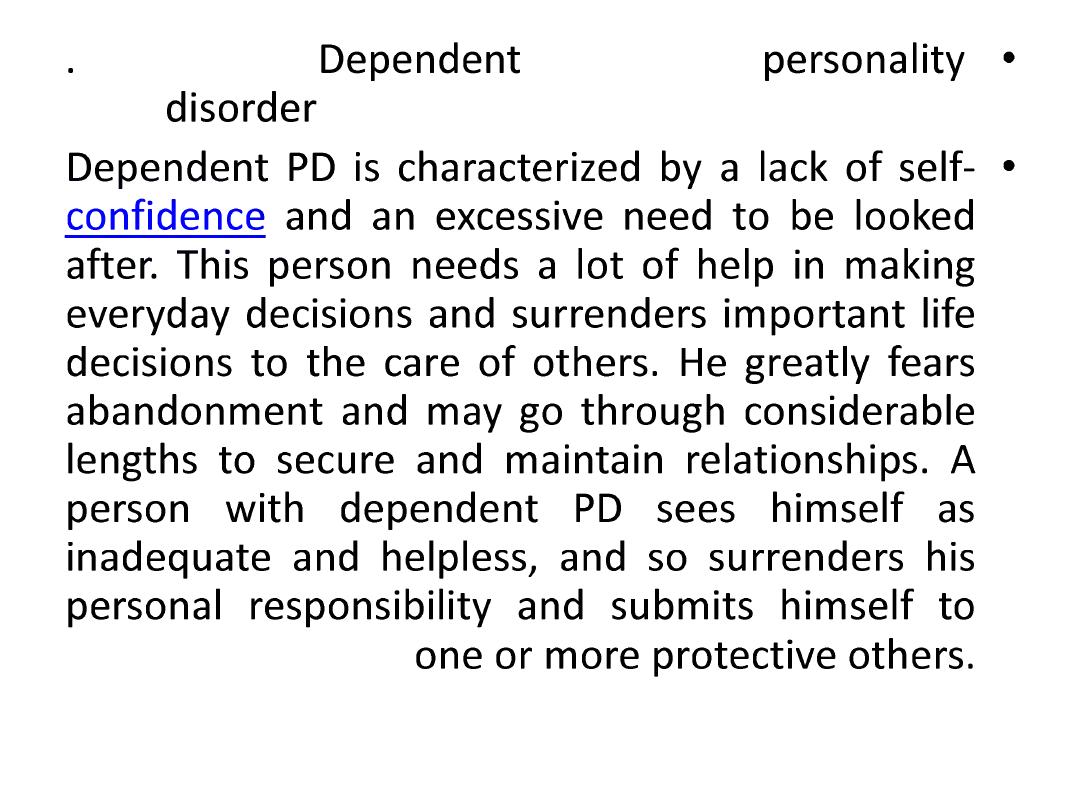
Dependent PD is characterized by a lack of self- •
confidence and an excessive need to be looked
after. This person needs a lot of help in making
everyday decisions and surrenders important life
decisions to the care of others. He greatly fears
abandonment and may go through considerable
lengths to secure and maintain relationships. A
person with dependent PD sees himself as
inadequate and helpless, and so surrenders his
personal responsibility and submits himself to
one or more protective others.
.
Dependent
personality •
disorder
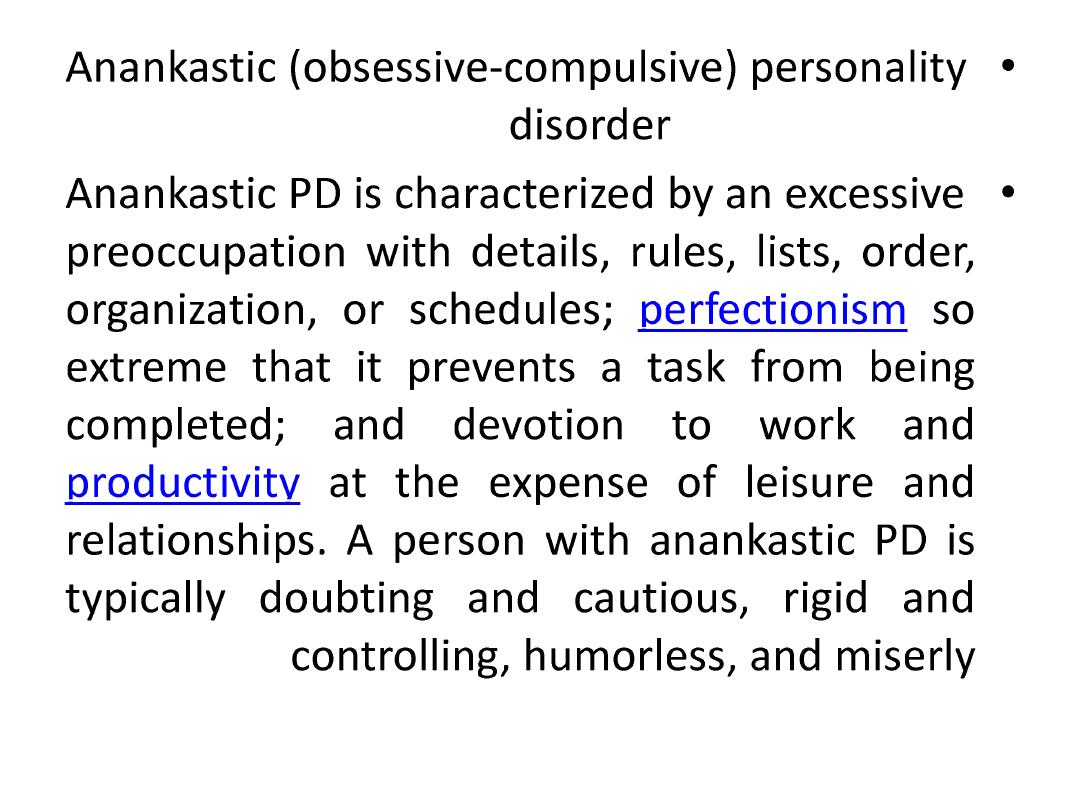
Anankastic PD is characterized by an excessive •
preoccupation with details, rules, lists, order,
organization, or schedules; perfectionism so
extreme that it prevents a task from being
completed; and devotion to work and
productivity at the expense of leisure and
relationships. A person with anankastic PD is
typically doubting and cautious, rigid and
controlling, humorless, and miserly
Anankastic (obsessive-compulsive) personality •
disorder
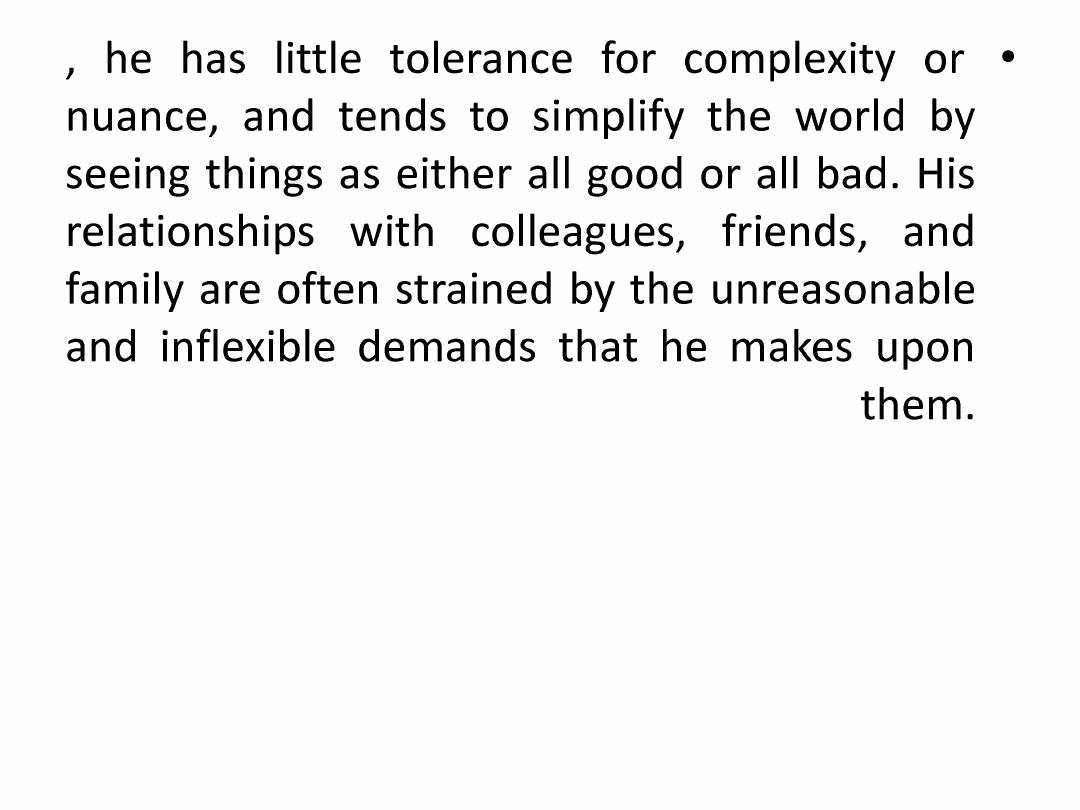
, he has little tolerance for complexity or •
nuance, and tends to simplify the world by
seeing things as either all good or all bad. His
relationships with colleagues, friends, and
family are often strained by the unreasonable
and inflexible demands that he makes upon
them.
